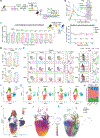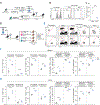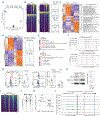Epigenetic regulators of clonal hematopoiesis control CD8 T cell stemness during immunotherapy
- PMID: 39388542
- PMCID: PMC11697317
- DOI: 10.1126/science.adl4492
Epigenetic regulators of clonal hematopoiesis control CD8 T cell stemness during immunotherapy
Abstract
Epigenetic reinforcement of T cell exhaustion is known to be a major barrier limiting T cell responses during immunotherapy. However, the core epigenetic regulators restricting antitumor immunity during prolonged antigen exposure are not clear. We investigated three commonly mutated epigenetic regulators that promote clonal hematopoiesis to determine whether they affect T cell stemness and response to checkpoint blockade immunotherapy. CD8 T cells lacking Dnmt3a, Tet2, or Asxl1 preserved a progenitor-exhausted (Tpex) population for more than 1 year during chronic antigen exposure without undergoing malignant transformation. Asxl1 controlled the self-renewal capacity of T cells and reduced CD8 T cell differentiation through H2AK119 ubiquitination and epigenetic modification of the polycomb group-repressive deubiquitinase pathway. Asxl1-deficient T cells synergized with anti-PD-L1 immunotherapy to improve tumor control in experimental models and conferred a survival advantage to mutated T cells from treated patients.
Figures




Comment in
-
Unwrapping stemness to revive T cells.Science. 2024 Oct 11;386(6718):148-149. doi: 10.1126/science.ads6217. Epub 2024 Oct 10. Science. 2024. PMID: 39388579
References
Publication types
MeSH terms
Substances
Grants and funding
LinkOut - more resources
Full Text Sources
Molecular Biology Databases
Research Materials

